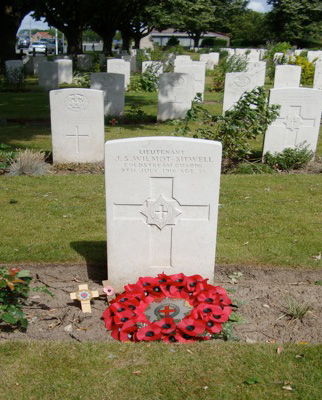Died of wounds received in action at age 21
Buried at Essex Farm Cemetery II.V.6
Jacinth Sacheverel was born in Horsley, one of the two sons of Edward Sacheverel and Caroline Agnes Wilmot-Sitwell, who also had five daughters. The family home since 1785 was Stainsby House, Smalley, Derbyshire, and Jacinth was baptised in the Parish Church on 5 May.
He went to Eton in 1907, up to Christ Church in 1911, and in the summer of 1914 to the Royal Military College Sandhurst.
On 17 February 1915, he was commissioned in the Coldstream Guards, arrived at the Victoria Barracks, Windsor on 1 April, and was promoted Lieutenant on 17 July, four days after his brother, Lt Stanton Degge, died while commanding a Company in the action of ’Achi Baba Nullah’ in Gallipoli.
From 27 July to 1 November 1915 Jacinth was with 3rd Battalion Coldstream Guards in the British Expeditionary Force in France in the preparation and run up to the battle of Loos, based in and around Lens. From 1 November 1915 to 20 April 1916 he was attached to 5th Battalion Coldstream Guards at Victoria Barracks, Windsor.
On 30 April 1916 he was posted back to 3rd Battalion Coldstream Guards in the Ypres salient. From 1-5 July he was with the Divisional Reserves in Camp E west of Ypres. On 6 July the Battalion moved in the evening to relieve 3rd Guards Brigade, leaving the reserve Battalion at Chateau Trois Tours. On 7 July 1916 they moved from Trois Tours in the evening to relieve 2nd Scots Guards. Left front Battalion, right Brigade. Located in the Moteldje line.
8 July 1916 3rd battalion Coldstream Guards diary: ‘3rd Coldstream ‘minenwerfered (see ‘note’ - below) at about 5am, otherwise quiet night. Various Royal Engineer and Right Group commanders came in. 3rd Coldstream ‘minenwerfered’ again about 3pm. Heavy retaliation put over which eventually stopped it. Wilmot-Sitwell very badly wounded and died in the Dressing Station at Essex Farm. Quiet evening until about 11pm when heavy bombardment opened southeast of Ypres and lasted 2 hours, the sky being lit with shells. This turned out to be the Canadians making an unsuccessful attempt to get back a strong point near Hoge.’
Note: Minenwerfer ("mine launcher") is the German name for a class of short-range mortars used extensively during the First World War by the German Army. The weapons were intended to be used by engineers to clear obstacles including bunkers and barbed wire that longer-range artillery would not be able to accurately target. Often used at the front line to fire across from one set of trenches to another at short range to cause disruption and casualties.
 Having been wounded Lt Wilmot-Sitwell firstly would have been treated by the platoon/Company medic and possibly the Battalion doctor. Once they had dealt as best they could he would have been taken by stretcher-bearers down a communication trench to near the then completely destroyed canal where he would have initially been treated in the surgery bunkers at Essex Farm. He died shortly afterwards.
Having been wounded Lt Wilmot-Sitwell firstly would have been treated by the platoon/Company medic and possibly the Battalion doctor. Once they had dealt as best they could he would have been taken by stretcher-bearers down a communication trench to near the then completely destroyed canal where he would have initially been treated in the surgery bunkers at Essex Farm. He died shortly afterwards.
Lt Jacinth Willmot-Sitwell’s grave at the Essex Farm Cemetery is shown right.
His name is also recorded at The Old School Room Etonian Memorial at St Georges’ Church, Ypres, the War Memorial in Brompton Oratory, and in St Thomas’s Church Walton where the north transept was converted into a memorial chapel in memory of those who died in the 1914-18 Great War.
His brother, Lt Stanton Degge of the Portsmouth RMLI Battalion is remembered on the Helles Memorial in Turkey, Panel 2

